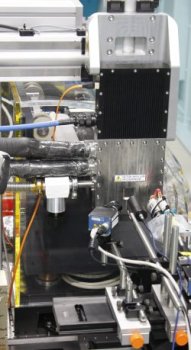Its name may be mud to some of us, but organic matter plays an essential role in soil and plant health – as well as harbouring inorganic (metal) and organic (pesticide) contaminants. Researchers have begun using synchrotron techniques to uncover new information about the structure and behaviour of soil organic matter.
Despite its importance for plant growth and environmental remediation, relatively little is known about some key aspects of soil organic matter, such as the distribution of different forms of organic matter in a particular soil, and the chemical environment surrounding beneficial and contaminant metals.
Enzo Lombi from the Centre for Environmental Contaminants and Remediation (CERAR) at the University of South Australia is using a range of synchrotron techniques to study trace metal distribution in plant and soil samples. Recent subjects include iron and zinc distribution in rice and barley, and copper, zinc and nickel uptake by plant roots.
Enzo and his CERAR colleagues Albert Juhasz and Erica Donner are currently working with Sean Forrester from CSIRO Land and Water in Adelaide and the Australian Synchrotron’s Daryl Howard, David Paterson and Martin de Jonge to explore how soil organic matter (natural and biochar) influences the absorption of metals and pesticides into soils.
 Biochar is a type of charcoal produced by burning biomass. It takes a very long time (hundreds of years or more) to be broken down by soil organisms and could potentially be used to sequester carbon so that it doesn’t contribute to global warming. Some studies suggest that biochar may influence the absorption of metals or pesticides, which could improve the availability of micronutrients (such as copper and zinc from fertilisers) but also increase the absorption of pesticides. In addition to their potential toxicity, some pesticides may lower the availability of important micronutrients such as copper and zinc.
Biochar is a type of charcoal produced by burning biomass. It takes a very long time (hundreds of years or more) to be broken down by soil organisms and could potentially be used to sequester carbon so that it doesn’t contribute to global warming. Some studies suggest that biochar may influence the absorption of metals or pesticides, which could improve the availability of micronutrients (such as copper and zinc from fertilisers) but also increase the absorption of pesticides. In addition to their potential toxicity, some pesticides may lower the availability of important micronutrients such as copper and zinc.
The collaborators are using a combination of synchrotron infrared and ‘hard’ x-ray techniques to examine and compare the distribution of soil organic matter, micronutrient metals (copper and zinc) and herbicides. Their aim is to develop and validate new experimental methods for further work in this area. Infrared microspectroscopy is a common tool for identifying organic materials such as pesticides and distinguishing these from other organic materials such as soil organic matter. Hard x-rays are more penetrating (and have shorter wavelengths) than soft x-rays, and are well-suited to identifying trace metals.
The work takes advantage of the much shorter data collection times made possible by the Maia detector system. In addition to the obvious time savings, rapid data collection also means a much lower risk of the hard x-rays damaging the samples.
Photo at right: the Maia detector system on the XFM beamline has substantially reduced data collection times.
